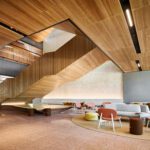
From the agora of ancient Greece to the high-rises of modern cityscapes – the spaces we create have shaped the way we live for thousands of years. Architecture – originally deriving from the Greek word arkhitekton or ‘master builder’ – is an essential and prestigious discipline; architects today play key roles in developing solutions to global challenges including population growth, climate change and health and wellbeing.
Do you want to study something purposeful and creative but not sure where to start? Studying architecture at Curtin could be a great option for you – we’re the top university in WA and in the top 100 universities globally for Architecture and the Built Environment (QS World University Rankings by subject 2024).
In this step-by-step guide, we’ll look at how to actually become an architect in Australia.
Step 1: Study a Bachelor of Architectural Science
Your journey to become an architect begins with enrolling in an undergraduate architecture degree. At Curtin, our Bachelor of Applied Science (Architectural Science), is a three-year (full-time) course where you’ll learn how to design homes, buildings and other structures, and explore the fascinating relationship between the natural and constructed environment.

“I was excited to see that Curtin had the best ranking for Architecture in WA and was among the best in Australia. The course structure, focus on industry-readiness and the overall atmosphere at Curtin were also big draw cards. The course also lets you explore all sorts of creative avenues, and the tutors are super supportive in helping you achieve your goals.”
Niamh Aitken-Lombardo, Bachelor of Applied Science (Architectural Science)
If you see yourself working as a building consultant or draftsperson, you can study this degree as a standalone option and graduate ready to start your career. If you want to become a practising architect, completing this degree is your first step. Next stop: postgraduate study! More on this in step three.
Choose a specialisation
Curtin offers specialisations in many of its courses. A specialisation comprises four units in a specific subject that complement your major without extending your course duration. A specialisation is designed to broaden your skills, expand your knowledge and can increase your job opportunities.
As an architecture student, you can specialise in one of the following: Animation and Game Architecture Design, Construction Management, Designing Fashion, Design Thinking and Visual Communication, Interior Architecture, and Principles of Planning.
Use industry standard tech
A standout feature of the course is its focus on technology. You can access the cutting-edge Makerspace, which has 3D printers, laser cutters, CNC milling machines, and wood and metal workshops. Technology is also embedded into the architecture units, including artificial intelligence, immersive experiences and digital fabrication.
Step 2: Design your student experience
As an architect student, you’ll get to study at Curtin’s award-winning School of Design and the Built Environment (DBE). You’ll be located in the heart of the vibrant Exchange Precinct, which has fantastic places to eat and socialise.
Discover Curtin’s clubs and societies
In between your studies there are plenty of ways to relax, have fun and make friends. For instance, you can join the Curtin Architecture Students Association (CASA) to meet and collaborate with other aspiring architects. You can also join one or more of the 100+ Student Guild clubs, which cater to diverse interests.
Gain experience with Work-Integrated Learning
Throughout your studies, you’ll have opportunities to undertake work experience with key industry partners such as Woods Bagot, Cox and Hassel. This work-integrated learning is built directly into the architecture course, ensuring you practise and develop industry relevant skills and build your networks.
GoGlobal with your degree
You can take your studies overseas through Curtin’s global initiatives, which include semester and year-long study exchange, study tours, internships and practicums.
For instance, in 2023, ten of our Architecture and Interior Architecture students completed a ten-week immersive experience in South Korea. They collaborated with students at Pai Chai University on a project visiting exceptional architectural works and finding novel design solutions. Our students also completed exciting internships at leading South Korean firms such as Gansam, STPMJ, and NOW.
Be sure to check out Curtin’s GoGlobal interactive map to explore study opportunities around the world.
Step 3: Complete your Master of Architecture

Once you’ve completed the Bachelor of Applied Science (Architectural Science), you’re ready for the next step to becoming an architect in Australia: study an architect program accredited by the Architects Accreditation Council of Australia (AACA). At Curtin, this is the Master of Architecture.
In this course you’ll examine architectural history, theory, management and law, all while expanding your professional practise. You’ll also undertake a thesis project in an area of your interest, ensuring you graduate with in-demand research skills and practical experience. This degree will elevate your expertise and professional identity.
Did you know? Our Master of Architecture has the highest employability rate in Western Australia.
Step 4: Gain professional registration
The final step to becoming an architect is completing the Architectural Practice Exam (APE), which leads to professional registration with the Architects Board of Western Australia (or relevant state or territory).
The APE comprises three parts:
Part 1: Complete a minimum of 3,300 hours (approximately two years) of practical experience, usually under the supervision of a registered architect. These hours are recorded in an APE logbook and accompanied by a statement of practical experience.
Part 2: Sit the National Examination Paper (NEP). This is a 70-minute closed book computer-based exam. The exam involves nine scenarios, each comprising five multiple choice questions and is conducted in test centres nominated by the Architects Accreditation Council of Australia (AACA).
Part 3: Attend an Examination by Interview. In this hour-long interview, two AACA examiners will assess you on your previous architecture work and experience.
Step 5: Now, go pursue your career as an architect
Congratulations! You can now officially call yourself an architect. An exciting, dynamic and prestigious career awaits.
Feeling inspired? Explore a universe of opportunities in architecture and the built environment.


